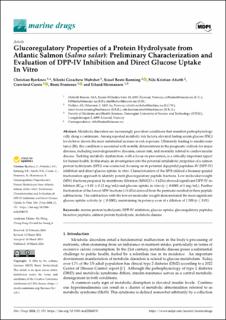| dc.contributor.author | Bjerknes, Christian | |
| dc.contributor.author | Wubshet, Sileshi Gizachew | |
| dc.contributor.author | Rønning, Sissel Beate | |
| dc.contributor.author | Afseth, Nils Kristian | |
| dc.contributor.author | Crawford, Currie | |
| dc.contributor.author | Framroze, Bomi | |
| dc.contributor.author | Hermansen, Erland | |
| dc.date.accessioned | 2024-04-24T07:25:30Z | |
| dc.date.available | 2024-04-24T07:25:30Z | |
| dc.date.created | 2024-04-18T14:54:31Z | |
| dc.date.issued | 2024 | |
| dc.identifier.citation | Marine Drugs. 2024, 22 (4), 1-18. | en_US |
| dc.identifier.issn | 1660-3397 | |
| dc.identifier.uri | https://hdl.handle.net/11250/3127847 | |
| dc.description.abstract | Metabolic disorders are increasingly prevalent conditions that manifest pathophysiologically along a continuum. Among reported metabolic risk factors, elevated fasting serum glucose (FSG) levels have shown the most substantial increase in risk exposure. Ultimately leading to insulin resistance (IR), this condition is associated with notable deteriorations in the prognostic outlook for major diseases, including neurodegenerative diseases, cancer risk, and mortality related to cardiovascular disease. Tackling metabolic dysfunction, with a focus on prevention, is a critically important aspect for human health. In this study, an investigation into the potential antidiabetic properties of a salmon protein hydrolysate (SPH) was conducted, focusing on its potential dipeptidyl peptidase-IV (DPP-IV) inhibition and direct glucose uptake in vitro. Characterization of the SPH utilized a bioassay-guided fractionation approach to identify potent glucoregulatory peptide fractions. Low-molecular-weight (MW) fractions prepared by membrane filtration (MWCO = 3 kDa) showed significant DPP-IV inhibition (IC50 = 1.01 ± 0.12 mg/mL) and glucose uptake in vitro (p ≤ 0.0001 at 1 mg/mL). Further fractionation of the lowest MW fractions (<3 kDa) derived from the permeate resulted in three peptide subfractions. The subfraction with the lowest molecular weight demonstrated the most significant glucose uptake activity (p ≤ 0.0001), maintaining its potency even at a dilution of 1:500 (p ≤ 0.01). | en_US |
| dc.language.iso | eng | en_US |
| dc.publisher | MDPI | en_US |
| dc.rights | Navngivelse 4.0 Internasjonal | * |
| dc.rights.uri | http://creativecommons.org/licenses/by/4.0/deed.no | * |
| dc.title | Glucoregulatory Properties of a Protein Hydrolysate from Atlantic Salmon (Salmo salar): Preliminary Characterization and Evaluation of DPP-IV Inhibition and Direct Glucose Uptake In Vitro | en_US |
| dc.title.alternative | Glucoregulatory Properties of a Protein Hydrolysate from Atlantic Salmon (Salmo salar): Preliminary Characterization and Evaluation of DPP-IV Inhibition and Direct Glucose Uptake In Vitro | en_US |
| dc.type | Journal article | en_US |
| dc.type | Peer reviewed | en_US |
| dc.description.version | publishedVersion | en_US |
| dc.source.pagenumber | 1-18 | en_US |
| dc.source.volume | 22 | en_US |
| dc.source.journal | Marine Drugs | en_US |
| dc.source.issue | 4 | en_US |
| dc.identifier.doi | 10.3390/md22040151 | |
| dc.identifier.cristin | 2262806 | |
| dc.relation.project | Norges forskningsråd: 314111 | en_US |
| dc.relation.project | Nofima AS: 202102 | en_US |
| dc.relation.project | Norges forskningsråd: 314599 | en_US |
| dc.relation.project | Nofima AS: 202101 | en_US |
| cristin.ispublished | true | |
| cristin.fulltext | original | |
| cristin.qualitycode | 1 | |

